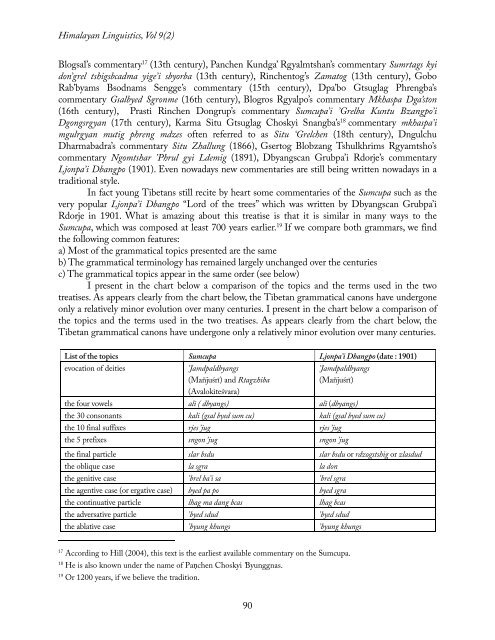The Classical Tibetan cases and their transcategoriality
The Classical Tibetan cases and their transcategoriality
The Classical Tibetan cases and their transcategoriality
Create successful ePaper yourself
Turn your PDF publications into a flip-book with our unique Google optimized e-Paper software.
Himalayan Linguistics, Vol 9(2)<br />
Blogsal’s commentary 17 (13th century), Panchen Kundga’ Rgyalmtshan’s commentary Sumrtags kyi<br />
don’grel tshigsbcadma yige’i sbyorba (13th century), Rinchentog’s Zamatog (13th century), Gobo<br />
Rab’byams Bsodnams Sengge’s commentary (15th century), Dpa’bo Gtsuglag Phrengba’s<br />
commentary Gsalbyed Sgronme (16th century), Blogros Rgyalpo’s commentary Mkhaspa Dga’ston<br />
(16th century), Prasti Rinchen Dongrup’s commentary Sumcupa’i ’Grelba Kuntu Bzangpo’i<br />
Dgongsrgyan (17th century), Karma Situ Gtsuglag Choskyi Snangba’s 18 commentary mkhaspa’i<br />
mgulrgyan mutig phreng mdzes often referred to as Situ ‘Grelchen (18th century), Dngulchu<br />
Dharmabadra’s commentary Situ Zhallung (1866), Gsertog Blobzang Tshulkhrims Rgyamtsho’s<br />
commentary Ngomtshar ’Phrul gyi Ldemig (1891), Dbyangscan Grubpa’i Rdorje’s commentary<br />
Ljonpa’i Dbangpo (1901). Even nowadays new commentaries are still being written nowadays in a<br />
traditional style.<br />
In fact young <strong>Tibetan</strong>s still recite by heart some commentaries of the Sumcupa such as the<br />
very popular Ljonpa’i Dbangpo “Lord of the trees” which was written by Dbyangscan Grubpa’i<br />
Rdorje in 1901. What is amazing about this treatise is that it is similar in many ways to the<br />
Sumcupa, which was composed at least 700 years earlier. 19 If we compare both grammars, we find<br />
the following common features:<br />
a) Most of the grammatical topics presented are the same<br />
b) <strong>The</strong> grammatical terminology has remained largely unchanged over the centuries<br />
c) <strong>The</strong> grammatical topics appear in the same order (see below)<br />
I present in the chart below a comparison of the topics <strong>and</strong> the terms used in the two<br />
treatises. As appears clearly from the chart below, the <strong>Tibetan</strong> grammatical canons have undergone<br />
only a relatively minor evolution over many centuries. I present in the chart below a comparison of<br />
the topics <strong>and</strong> the terms used in the two treatises. As appears clearly from the chart below, the<br />
<strong>Tibetan</strong> grammatical canons have undergone only a relatively minor evolution over many centuries.<br />
List of the topics Sumcupa Ljonpa’i Dbangpo (date : 1901)<br />
evocation of deities ’Jamdpaldbyangs<br />
(Mañjuśrī) <strong>and</strong> Rtagzhiba<br />
(Avalokiteśvara)<br />
90<br />
’Jamdpaldbyangs<br />
(Mañjuśrī)<br />
the four vowels ali ( dbyangs) ali (dbyangs)<br />
the 30 consonants kali (gsal byed sum cu) kali (gsal byed sum cu)<br />
the 10 final suffixes rjes ’jug rjes ’jug<br />
the 5 prefixes sngon ’jug sngon ’jug<br />
the final particle slar bsdu slar bsdu or rdzogstshig or zlasdud<br />
the oblique case la sgra la don<br />
the genitive case ’brel ba’i sa ’brel sgra<br />
the agentive case (or ergative case) byed pa po byed sgra<br />
the continuative particle lhag ma dang bcas lhag bcas<br />
the adversative particle ’byed sdud ’byed sdud<br />
the ablative case ’byung khungs ’byung khungs<br />
17 According to Hill (2004), this text is the earliest available commentary on the Sumcupa.<br />
18 He is also known under the name of Paṇchen Choskyi 'Byunggnas.<br />
19 Or 1200 years, if we believe the tradition.
















